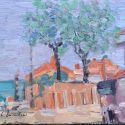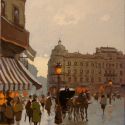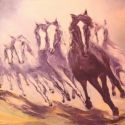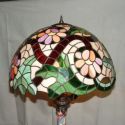
photo:
http://3.bp.blogspot.com/_M_N1vqPdw3I/S_fy8oGrn-I/AAAAAAAAAKg/HzzsBG0gTJM/s1600/Charlie+Chaplin.jpg
Biography
Born:
April 16, 1889
Walworth, London, England
Died:
December 25, 1977
Vevey, Switzerland
Occupation:
Actor, writer, director, producer, composer
Charlie Chaplin and Virginia Cherrill in City Lights (1931)
Sir Charles Spencer Chaplin, Jr, KBE, (April 16, 1889–December 25, 1977), known as Charlie Chaplin, was a British-born actor, the most famous actor in early to mid Hollywood cinema era, and also a notable director. His principal character was "The Tramp": a vagrant with the refined manners and dignity of a gentleman who wears a tight coat, oversized pants and shoes, a derby or bowler hat, a bamboo cane, and his signature toothbrush moustache. Chaplin was one of the most creative personalities in the silent film era; he acted in, directed, scripted, produced, and eventually scored his own films.
Contents
1 Birth
2 Childhood
3 Stage
4 America
5 Auteur
6 United Artists
7 The Great Dictator
8 Politics
9 McCarthyism
10 Academy Awards
11 Relationships
11.1 Mildred Harris
11.2 Lita Grey
11.3 Paulette Goddard
11.4 Joan Barry
11.5 Oona O'Neill
12 Knighthood
13 Death
14 Misinformation
15 Legacy
16 Media
17 Trivia
18 Filmography
18.1 Short films as actor
18.2 Feature films
19 See also
20 External links
21 Notes
Birth
He was believed to have been born on April 16, 1889 [1]. There is some doubt whether April 16 is actually his birthday, and it is possible he was not born in 1889. There is also uncertainty about his birthplace: London or Fontainebleau, France. There is no doubt, however, as to his parentage: he was born to Charles Chaplin, Sr. and Hannah Harriette Hill (aka Lily Harley on stage), both Music Hall entertainers. His parents separated soon after his birth, leaving him in the care of his increasingly unstable mother.
Childhood
A postage stamp issued by India
In 1896, Chaplin's mother was unable to find work; Charlie and his older half-brother Sydney Chaplin had to be left in the workhouse at Lambeth, moving after several weeks to Hanwell School for Orphans and Destitute Children. His father died an alcoholic when Charlie was 12, and his mother suffered a mental breakdown, and was eventually admitted temporarily to the Cane Hill Asylum at Coulsdon (near Croydon). She died in 1928 in the United States, two years after coming to the States to live with Chaplin, by then a commercial success.
Stage
Charlie first took to the stage when, aged five, he performed in Music Hall in 1894, standing in for his mother. As a child, he was confined to a bed for weeks due to a serious illness, and, at night, his mother would sit at the window and act out what was going on outside. In 1900, aged 11, his brother helped get him the role of a comic cat in the pantomime Cinderella at the London Hippodrome. In 1903 he appeared in 'Jim, A Romance of Cockayne', followed by his first regular job, as the newspaper boy Billy in Sherlock Holmes, a part he played into 1906. This was followed by Casey's 'Court Circus' variety show, and, the following year, he became a clown in Fred Karno's 'Fun Factory' slapstick comedy company.
America
According to immigration records, he arrived in the United States with the Karno troupe on October 2, 1912. In the Karno Company was Arthur Stanley Jefferson, who would later become known as Stan Laurel. Chaplin and Laurel wound up sharing a room in a boarding house. Stan Laurel returned to England but Chaplin remained in the United States. Chaplin's act was seen by film producer Mack Sennett, who hired him for his studio, the Keystone Film Company.
While Chaplin initially had difficulty adjusting to the Keystone style of film acting, he soon adapted and flourished in the medium. This was made possible in part by Chaplin developing his signature Tramp persona, by eventually earning directorship and creative control, which enabled him to become Keystone's top star and talent.
"Kid auto races at Venice" (1914) Chaplin's 2nd film and debut of the "tramp" character.
His salary history shows how rapidly he became world famous, and the skill of his brother, Sydney, at being his business manager.
1914: Keystone, worked for $150 a week
1914-1915: Essanay Studios, of Chicago, Illinois, $1250 a week, plus $10,000 signing bonus
1916-1917: Mutual, $10,000 a week, plus $150,000 signing bonus
1917: First National, $1 million deal — the first actor ever to earn that sum. He also formed his own independent production company, the Charles Chaplin Film Corporation, which made him a very wealthy man
Auteur
Chaplin built his own Hollywood studio in 1918, and assumed an unparalleled degree of artistic and financial control over his productions. Using this independence, over the next 35 years he created a remarkable, timeless body of work that remains entertaining and influential. These include comedy shorts including: A Dog's Life (1918), and Pay Day (1922); longer films, such as: Shoulder Arms (1918) and The Pilgrim (1923); and his great silent feature length films, among them: The Kid (1921), A Woman of Paris (1923), The Gold Rush (1925), and The Circus (1928). After the arrival of sound films, he made City Lights (1931) and Modern Times (1936), essentially silent films scored with his own music and sound effects. His dialogue films made in Hollywood were The Great Dictator (1940), Monsieur Verdoux (1947), and Limelight (1952).
"Modern Times" (1936) depicts the dismal situation of workers and the poor in industrial society. The Eating Machine Scene depicts the dehumanizing effect of mechanization.
While Modern Times (1936) is a non-talkie, it does contain talk -- usually coming from inanimate objects such as a radio or a TV monitor. This was done to help 1930s audiences, who were out of the habit of watching silent films, adjust to not hearing dialogue. Chaplin being observed by his boss while sneaking a smoke in the bathroom came before George Orwell's "Big Brother" by more than a decade, and might have inspired it. Modern Times was the first film where Chaplin's voice is heard (in the nonsense song at the end). However, for most viewers it is still considered a silent film.
United Artists
In 1919 he founded the United Artists film distribution company with Mary Pickford, Douglas Fairbanks and D. W. Griffith, and served on the board of UA until the early 1950s.
Although "talkies" became the dominant mode of moviemaking soon after they were introduced in 1927, Chaplin resisted making a talkie all through the 1930s. It is a tribute to Chaplin's versatility that he also has one film credit for choreography for the 1952 film Limelight, and one credit as a singer for the title music of the 1928 film The Circus. The best-known of several songs he composed are "Smile", famously covered by Nat King Cole, among others, and the theme from Limelight.
"The Great Dictator" (1940) was an act of defiance against Adolf Hitler and fascism. Chaplin played a fascist dictator clearly modeled on Hitler (also with a certain physical likeness).
The Great Dictator
His first dialogue picture, The Great Dictator (1940) was an act of defiance against Adolf Hitler and fascism, filmed and released in the United States one year before it abandoned its policy of isolationism to enter World War II. The film was seen as an act of courage in the political environment of the time, both for its ridicule of Nazism and for the portrayal of overt Jewish characters and the depiction of their persecution. Chaplin played a fascist dictator clearly modeled on Hitler (also with a certain physical likeness), as well as a Jewish barber cruelly persecuted by the Nazis. Hitler, who was a great fan of movies, is known to have seen the film twice (records were kept of movies ordered for his personal theater). Interestingly, Chaplin and Hitler were born only four days apart (Hilter was born on April 20, 1889).
Charlie Chaplin (not as a Jewish barber, but as himself) in "The Great Dictator" (1940)
Politics
Chaplin's political sympathies always lay with the left. His politics seem tame by modern standards, but after the 1940's his views (in conjunction with his influence and fame) were seen by many as dangerously radical. His silent films made prior to the Great Depression typically did not contain overt political themes or messages, apart from the Tramp's plight in poverty and his run ins with the law. But his films made in the 1930's were more openly political. Modern Times (1936) depicts the dismal situation of workers and the poor in industrial society. The final dramatic speech in his 1940 film The Great Dictator, which was critical of patriotic nationalism, was highly controversial, as was his vocal public support for the opening of a second European front in 1942 to assist the Soviet Union in World War II. The critical view of capitalism in his 1947 black comedy Monsieur Verdoux was hugely controversial, with the film being protested at many US cities.
Charlie Chaplin and Mahatma Gandhi. Concidentally, both of these men had biopics made about them by Richard Attenbourough.
McCarthyism
Although Chaplin had his major successes in the United States and was a resident from 1914 to 1952, he retained his British nationality. During the era of McCarthyism, Chaplin was accused of "un-American activities" as a suspected communist; and J. Edgar Hoover, who had instructed the FBI to keep extensive files on him, tried to end his United States residency. FBI pressure on Chaplin grew after his 1942 campaign for a second front in the war, and reached a critical level in the late 1940's, when Congressional figures threatened to call him as a witness in hearings. This was never done, probably because of fear of Chaplin's ability to ridicule and lampoon the investigators.
In 1952, Chaplin left the US for a trip to England; Hoover learned of it and negotiated with the INS to revoke his re-entry permit. Chaplin then decided to stay in Europe, and made his home in Vevey, Switzerland. He briefly returned to the United States in April 1972, with his wife, to receive an Honorary Oscar. Even though he was invited by the Academy of Motion Picture Arts and Sciences (the Academy Awards), he was only issued a one-time entry visa valid for two months.
Chaplin and Jackie Coogan in "The Kid" (1921)
Academy Awards
Chaplin won two honorary Oscars. When the first Oscars were awarded on May 16, 1929, the voting audit procedures that now exist had not yet been put into place, and the categories were still very fluid. Chaplin had originally been nominated for both Best Actor and Best Comedy Directing for his movie The Circus, but his name was withdrawn and the Academy decided to give him a special award "for versatility and genius in acting, writing, directing and producing The Circus" instead. The other film to receive a special award that year was The Jazz Singer.
Chaplin's second honorary award came 44 years later in 1972, and was for "the incalculable effect he has had in making motion pictures the art form of this century". He came out of his exile to accept his award. Upon receiving the award, Chaplin received the longest standing ovation in Academy Award history, lasting a full five minutes from the delighted, enthralled star-studded studio audience.
Chaplin was also nominated without success for Best Picture, Best Actor, and Best Original Screenplay for The Great Dictator, and again for Best Original Screenplay for Monsieur Verdoux (1947).
It is sometimes overlooked that Chaplin also won a competitive Academy Award. In 1973, he received an Oscar for the Best Music in an Original Dramatic Score for the 1952 film Limelight, which co-starred Claire Bloom. The film also features a cameo with Buster Keaton, which was the first and last time the two great comedians ever appeared together. Because of Chaplin's difficulties with McCarthyism, the film did not open in Los Angeles when it was first produced. This criterion for nomination was not fulfilled until 1972.
His final films were A King in New York (1957) and A Countess From Hong Kong (1967), starring Sophia Loren and Marlon Brando.
Relationships
Mildred Harris
Chaplin's professional successes were repeatedly overshadowed by his private life, particularly with regard to his politics and his pattern of relationship with young women. On October 23, 1918, the 28 year old Chaplin married the 16-year-old Mildred Harris. They had one child, Norman Spencer Chaplin, who died in infancy; they divorced in 1920. During the divorce Chaplin claimed Harris had had a lesbian affair with noted actress of the time Alla Nazimova, well known for seducing young actresses. Harris in turn claimed Chaplin was a sexual addict into very unusual sex activities. Both claims have merit.
Lita Grey
At 35, he became involved with 16-year-old Lita Grey during preparations for The Gold Rush. They married on November 26, 1924 after she became pregnant. They had two sons, the actors Charles Chaplin Jr. (1925-1968) and Sydney Earle Chaplin. Their extraordinarily bitter divorce in 1928 had Chaplin paying Grey a then-record-breaking $825,000 settlement. The stress of the sensational divorce, compounded by a tax dispute, allegedly turned his hair white. The publication of court records, which included many intimate details, led to a campaign against him.
Paulette Goddard
Chaplin and actress Paulette Goddard were involved in a romantic and professional relationship between 1932 and 1940, with Goddard living with Chaplin in his Beverly Hills home for most of this time. After the relationship ended, Chaplin made public statements that they had been secretly married in 1936, but in private he claimed they were in fact never officially married. In any case, their common-law marriage ended amicably in 1942, with Goddard being granted a divorce and settlement.
Joan Barry
Chaplin briefly dated actress Joan Barry, but ended it when she started harassing him and displaying signs of severe mental illness. In May 1943, she filed a paternity suit against him. Blood tests proved Chaplin was not the father, but as blood tests were inadmissible evidence in court, he was ordered to pay $75 a week until the child turned 21.
Oona O'Neill
Shortly thereafter, he met Oona O'Neill, daughter of Eugene O'Neill, and married her on June 16, 1943. He was 54; she was 17. This happened in the face of her father's refusal to give his permission; he said that if they went through with the marriage, he would never speak to Oona again. As far as is known, he kept his word. Despite this, the marriage was a long and happy one, with eight children. They had three sons: Christopher, Eugene and Michael Chaplin and five daughters: Geraldine, Josephine, Jane, Victoria and Annette-Emilie Chaplin.
Charlie Chaplin and Paulette Goddard in "Modern Times" (1936)
Knighthood
On March 4, 1975, he was knighted as a Knight Commander of the British Empire (KBE) by Queen Elizabeth II. The honour was first proposed in 1956, but was vetoed by the British Foreign Office on the grounds that he sympathized with the left and that it would damage British relations with the United States, at the height of the Cold War and with planning for the ill-fated invasion of Suez underway.
Death
Chaplin died on Christmas Day, 1977, in Vevey, Switzerland, following a stroke, aged 88, and was interred in Corsier-Sur-Vevey Cemetery in Corsier-Sur-Vevey, Vaud. On March 1, 1978, his body was stolen in an attempt to extort money from his family. The plot failed, the robbers were captured, and the body was recovered 11 weeks later near Lake Geneva.
Misinformation
Some have said or suggested Chaplin was Jewish. It is unclear how this rumour began. One anti-Semite, George Lincoln Rockwell founder of the American Nazi Party, claimed Chaplin's real name was Israel Thonstein.[2] There has never been any documentation showing Charlie Chaplin was Jewish and he made a point of not giving an answer so as to not dignify the question, as to deny would imply that Jewish ancestry is something to be ashamed of.
Legacy
There is a statue of Chaplin in front of the alimentarium in Vevey to commemorate the last part of his life.
The fourth week of March is celebrated as Charlie Chaplin week. The week is especially popular on college campuses. Observances vary, but usually include the display of bowler hats, canes, and moustaches.
Amongst his many honours, Chaplin has a star on the Hollywood Walk of Fame and in 1985 he was honoured with his image on a postage stamp of the United Kingdom and in 1994 he appeared on a United States postage stamp designed by caricaturist Al Hirschfeld.
In 1992 a film was made about his life entitled Chaplin, directed by Oscar-winner Lord Richard Attenborough, and starring Robert Downey Jr., Dan Aykroyd, Geraldine Chaplin (Charlie's daughter, portraying Charlie's mother, her own grandmother), Sir Anthony Hopkins, Milla Jovovich, Moira Kelly, Kevin Kline, Diane Lane, Penelope Ann Miller, Paul Rhys, Marisa Tomei, Nancy Travis, and James Woods.
In 2001, British comedian Eddie Izzard played Chaplin in the film, The Cat's Meow, which theorized about the still-unsolved death of producer Thomas Ince aboard William Randolph Hearst's yacht, of which Chaplin was a passenger of at the time.
Media
"The bond of friendship" (file info)
A video clip from the silent film, "The Bond" (1918).
"The marriage bond" (file info)
A video clip from the silent film, "The Bond" (1918).
"U.S. Liberty Bonds" (file info)
A video clip from the silent film, "The Bond" (1918).
Charlie Chaplin gets hit by Cupid (file info)
This clip has Chaplin falling in love with a beautiful woman, with some help from Cupid.
Problems seeing the videos? See Media help.
Trivia
Geraldine Chaplin played her own grandmother, Hannah Chaplin, in Richard Attenborough's 1992 film "Chaplin"
A bronze statue to Chaplin was erected in the small seaside town of Waterville, Co. Kerry, Ireland where the star spent many holidays in later life.
A young Chaplin is a character in Shanghai Knights; the movie presented the fictional idea that Chaplin originally came to America by stowing away with Jackie Chan and Owen Wilson's characters.
It is true that Charlie Chaplin once lost a "Charlie Chaplin look-a-like" competition. As Chaplin became popular throughout America, Chaplin look-a-like competitions became popular. On one occasion, a rising young actor called Bob Hope took first prize!
Chaplin was a friend of Luis Buñuel in the early 30s.
In a 2005 poll to find The Comedian's Comedian, he was voted among the top 20 greatest comedy acts ever by fellow comedians and comedy insiders.
All his life, Chaplin was known to be an avowed atheist. He had nothing but contempt for any form of religion. He once joked, "I would love to play the part of Jesus! I fit it perfectly because I am a comedian."
Chaplin and Hitler were supposedly born in the same week in 1889.
In his later years Chaplin was a fan of Benny Hill, a compliment that touched Benny so much when he visited Chaplin's home via an invite from Chaplin's family in 1991 and discovered that Charlie had a vast collection of Benny Hill videos.
Filmography
Short films as actor
1914
A Busy Day
Caught in a Cabaret
Caught in the Rain
Cruel, Cruel Love
Dough and Dynamite
The Face on the Bar Room Floor
The Fatal Mallet
A Film Johnnie
Gentlemen of Nerve
Getting Acquainted
Her Friend the Bandit
His Favorite Pastime
His Musical Career
His New Profession
His Prehistoric Past
His Trysting Place
Kid Auto Races at Venice
The Knockout
Laughing Gas
Mabel at the Wheel
Mabel's Busy Day
Mabel's Married Life
Mabel's Strange Predicament
Making a Living
The Masquerader
The New Janitor
The Property Man
Recreation
The Rounders
The Star Boarder
Tango Tangles
Those Love Pangs
Twenty Minutes of Love
1915
The Bank
Charlie Chaplin's Burlesque on Carmen
By the Sea
The Champion
His New Job
His Regeneration
In the Park
A Jitney Elopement
A Night Out
A Night in the Show
Shanghaied
The Tramp
A Woman
Work
1916
Behind the Screen
The Count
The Fireman
The Floorwalker
One A.M.
The Pawnshop
Police!
The Rink
The Vagabond
1917
The Adventurer
The Cure
Easy Street
The Immigrant
1918
The Bond
Shoulder Arms
A Dog's Life
Triple Trouble
1919
A Day's Pleasure
Sunnyside
1921
The Idle Class
1922
Pay Day
1923
The Pilgrim
Feature films
(as actor and director except as noted)
Tillie's Punctured Romance (1914) (actor only) - first feature-length comedy film ever produced.
The Kid (1921)
The Nut (1921) (cameo only)
Souls For Sale (1923) (cameo only)
A Woman of Paris (1923) (cameo, dir)
The Gold Rush (1925)
A Woman of the Sea (1926) (produced only)
The Circus (1928)
Show People (1928) (cameo only)
City Lights (1931)
Modern Times (1936)
The Great Dictator (1940)
Monsieur Verdoux (1947)
Limelight (1952)
A King in New York (1957)
A Countess From Hong Kong (1967) (directed and makes a cameo appearance)

































